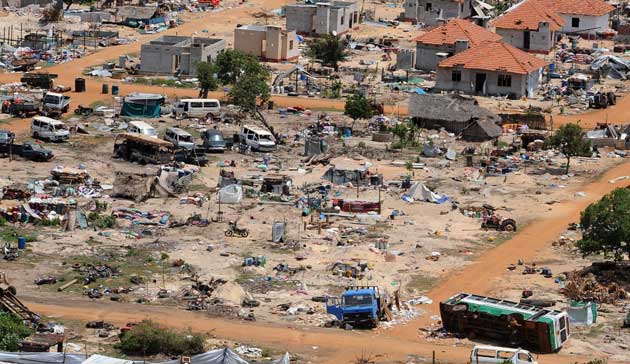The cratered wasteland where thousands died
UN chief's visit reveals the full horrors of Sri Lanka's war zone where civilians and rebels were trapped

Sri Lanka's former war zone is a wasteland, its earth scorched and pocked by craters. Cars and trucks lie overturned near bunkers beside clusters of battered tents.
The government has denied firing heavy weapons into what had been a battlefield densely populated with civilians. But the helicopter tour the military gave the UN Secretary-General Ban Ki-moon and a group of journalists yesterday revealed widespread devastation.
The sandy coastal strip where the final battles of the 25-year civil war were fought was dotted with patches of charred earth and dark craters were visible amid the greyish earth. One area was thick with endless rows of tents, many flattened and damaged. Abandoned vehicles were overturned, some reduced to burnt skeletons. Some huts with thatched roofs were destroyed, others had no roofs at all.
After touring the area, Mr Ban said the trapped civilians must have undergone "most inhumane suffering".
The government declared victory on Monday in the civil war that began in 1983. In the final weeks, with the rebels boxed into a tiny coastal strip and tens of thousands of civilians trapped inside, the government said it would no longer fire heavy weapons.
But government doctors in the area – as well as human rights groups and foreign leaders – said intense shelling continued, killing hundreds of civilians. The UN Human Rights Council is planning a special session on Sri Lanka on Monday in Geneva, amid international calls for a war crimes investigation into the military's conduct. According to private UN documents, at least 7,000 civilians were killed in the final months of fighting.
The military said again yesterday that it had not shelled the area, and blamed the craters on rebel fighters. "We heard many explosions, even in the last days, as they exploded their ammunition dumps," said Brigadier Udaya Nanayakkara,
But many of the trapped civilians, now living behind barbed wire in displacement camps, spoke of unrelenting shelling. "We walked for three days to get here. We were shelled and bombed. There was no food. Both sides were shelling us," said an elderly woman who gave her name as Lechchami. Another said her family came under shelling from the military and one of her children was killed.
At the Manik Farm displacement camp, some civilians said there was little food or water. They complained that they were not allowed to leave and their male relatives had been detained by the military, presumably under suspicion of being rebel fighters.
Mr Ban appealed to the government to improve conditions for the almost 300,000 ethnic Tamil civilians displaced by the fighting. He also called for aid groups to get unfettered access to the camps and welcomed President Mahinda Rajapaksa's promise to resettle the bulk of the displaced by the end of the year. "We will try to work hard to make sure that promise is realised," he said.
Mark Cutts, a senior UN humanitarian officer, said Manik Farm was erected almost overnight and is the world's largest displacement camp. "There are 200,000 people here. This is a very overcrowded place, a very big place, and there's a lot of work still to be done. Conditions, you can see, they're very basic," he said.
Sri Lanka's ministry of health said yesterday it was "investigating" the arrest of three government doctors by the military as they fled the war zone last week. The three, Thurairaja Varatharajah, Thangamuttu Sathyamurthi and V Shanmugarajah, are accused of giving false information to the media about civilian casualties.
The doctors, who provided the very few sources of information about conditions after journalists were banned from the area, said they treated hundreds of badly wounded civilians in understaffed, makeshift hospitals in the north during the military's final offensive against the rebels.
Join our commenting forum
Join thought-provoking conversations, follow other Independent readers and see their replies
Comments
Bookmark popover
Removed from bookmarks